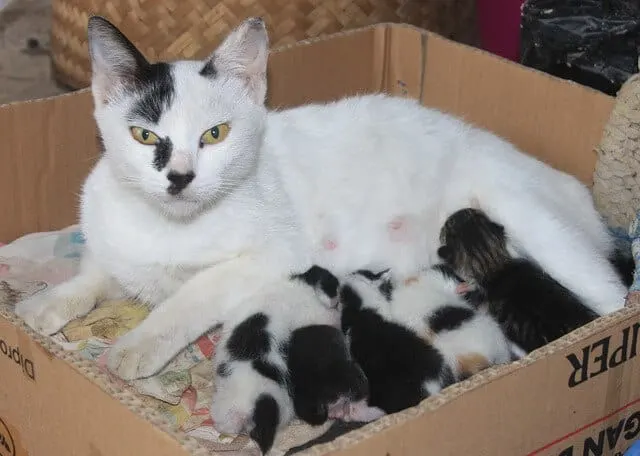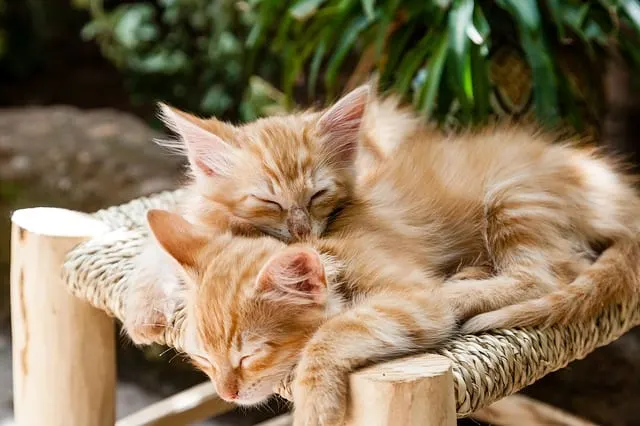Have you encountered a lost-looking kitty in your backyard or neighborhood? Seeing a cat that appears in need of help is hard enough, but if you notice they seem to be carrying an extra load around the middle you might start to wonder…a pregnant stray cat – what do I do?!
If you’re a cat lover, like us here at Fluffy Kitty, you’ll likely want to offer the pregnant momma some help. But how? What should you do, and what shouldn’t you do?
In this article, we will cover all the essential information you need to best care for a furry mom-to-be, including:
- How to know if a cat is stray or feral
- Signs of pregnancy in cats
- What to feed a pregnant cat
- How to tell when a feral cat is ready to give birth
- Aftercare for feral mother cats and her kittens
Let’s start with the most important question – is this momma cat actually in need of help?
A pregnant cat that is owned and cared for might be easy to spot, but sometimes you can be a little unsure.
Discerning a neighborhood cat from a stray or feral can be tricky, as they so easily can slip their safety collars these days.
On another note, a feral cat may accept food but won’t want or need any help with her kittens. Whereas a stray cat will usually seek out your help.
In any case – you wouldn’t want to make the mistake of handling them or unnecessarily stressing them out if they don’t actually need your assistance.

How Can You Tell if a Pregnant Cat Is Genuinely in Need of Help?
We have a deeper look at this on our blog: Should I Feed This Cat? A Guide to Feral, Stray, & Neighborhood Cats, so if you want to fully understand the nuances between each kind of kitty then give that a read!
For now, this handy table can help you identify a feral or stray cat vs a wandering pet:
| Outdoor Pet | Stray Cat | Feral Cat | |
| Healthy Weight | ✔ | X | ✔/X |
| Good Coat Condition | ✔ | X | ✔/X |
| Approachable | ✔ | ✔/X | X |
| Prone to Begging | X | ✔ | X |
| Wandering in Daytime | ✔ | X | X |
| Wandering at Night or Dawn | X | ✔ | ✔ |
| ID | ✔ | X | X |
If you are sure you have encountered a stray kitty that seems to need help, your next step is to discern if the cat is actually pregnant. So let’s look at how you tell when a feral or stray cat is ready to give birth.
Pregnancy Symptoms in Stray Cats:
Physical
The two most common signs are a swollen belly and darkened nipples.
Cats have very quick pregnancies, so if you’ve seen the cat around before, you will notice a radical change in their physique quite quickly. This can help to differentiate between simple weight gain and a real pregnancy.
The mother’s belly will be very rounded, while staying lean in the rest of the body, and will hang lower when she stands.
If you can get close enough to the cat, you might also be able to see some movement inside.
Behavioral
A soon-to-be mother cat may exhibit nesting behaviors, especially towards the end of her pregnancy. So she will be looking for a warm, quiet place to give birth – this may mean she is a more frequent visitor and seems more persistent to get inside.
Appetite will increase for a pregnant stray, so this may mean she becomes more vocal and insistent and eats larger quantities of food.
Just like humans, some pregnant cats experience morning sickness! So you may notice some vomiting – though this may be harder to discern unless you have a better sense of what ‘normal’ is for this stray.
How to Help a Pregnant Stray Cat?
Before Delivery
So you have determined that yes this stray cat is pregnant – how to help?
Go Slowly
Avoid physical contact unless the cat seems willing to accept it, so as to not cause any excess stress. This may mean you need to spend some time befriending the momma and gaining her trust. This may take anywhere from a few days to a week, as pregnant kitties can be a little more wary than usual.
Start With Food & Water
While you are building trust, the best thing to do is provide food and water to help her stay healthy and hydrated. Place them in a spot that is sheltered and safe. This may help to slowly acclimatize her to your presence, moving a little closer each time she visits.
What to Feed a Pregnant Stray Cat?
Ideally, a momma cat needs a high-quality kitten/growth/development food in multiple small meals – especially small if the food is new to her to avoid any stomach upset.
If you haven’t got any food to hand, follow our guide for What to Feed a Stray Cat Without Cat Food.
Offer a Nest
As the birth approaches, a pregnant stray is searching for a safe, secure and isolated place to give birth. This may be the opportunity to guide her inside to a prepared space, like a wardrobe or secluded box with some toweling. Be sure to keep her away from your other pets too. If she won’t come inside you can make an outdoor nest using a tutorial like this one.
Vet Check
If possible, and you think it wouldn’t cause excess stress, see if you can take the mother for a wellness check with your vet. They’ll be able to offer you some advice on the delivery, and whether the mother cat is microchipped. If not, a phone call with your vet could give you peace of mind around helping with a safe delivery.
Keep a Distance
If you sense that the momma is nervous around you, keep your distance, especially during the birth. But do keep an eye on how she is doing, perhaps by putting a web camera or baby monitor around the den area, and if you notice any of the following it’s best to call your vet:
- Straining for longer than 40-60 minutes with no kitten arriving
- A kitten seems to be stuck
- The mother seems overly distressed
- She is overly lethargic
- She is bleeding heavily
After Delivery
Once your stray or feral mother cat and kittens are well after delivery – what next?

Hold Back
As hard as it is to ignore those little fluff balls, don’t handle the kittens during the first few days after birth. Unless, of course, it is absolutely necessary to get them to a vet because you are worried about signs of illness. Keeping a distance reduces the likelihood that the mother will abandon her kittens. Don’t worry, if she’s ready to introduce them to you you’ll know.
Keep Them Together
If you are concerned about something and want to see the vet, take the whole family together to reduce stress and the possibility of abandonment.
Play Area
If the kittens were born in your home, and you plan to foster them for the time being, it might be a good idea to set up a kitten-proof room for them to grow up in. As they grow, they’ll want to explore and play, so will need space in which it is safe to do so.
How to Take Care of a Kitten Without a Mother?
Sometimes it’s not the mother that wanders into our life, but her lost babies. Here’s how to help a lost kitten:
- Maintain a distance, to begin with, in case momma is coming back. Kittens have a much higher survival rate if they are with mom, so be as patient as you can.
- If they are very young (eyes and ears closed) monitor them for around 2 hours. If there is no sign of mum, or the kitten is clearly in a high state of distress, then call a local vet, rescue, or advice line and inform them you are taking the kitten in. They can help with whether you need emergency assistance or whether you can nurse the kitten yourself.
- Older kittens might be left for around 4 hours, so wait a little longer before moving ahead with any rescue attempt.
What to Feed Newborn Kittens in an Emergency?
If you find yourself needing to care for a kitten with no supplies, try the following:
- Start by making sure they are warm – with an old towel and a heating pad or hot water bottle (be sure to supervise the use of any hot water bottles).
- Use some evaporated milk with warm water (50/50), yogurt or goat’s milk with a syringe or dropper feed. The general rule of thumb is around 5ml per day of age.
- Kittens will usually need to be fed every 1 to 3 hours.
- As soon as you can, get some Kitten Replacement Milk.
Long Term Plans
You’ve already done an amazing thing by opening your home to this momma and her babies. So well done!
Your next steps are entirely up to you, but here are some recommendations to help mom and kittens have a long happy life.
Mother – If you brought the mother cat into your home to finish out her pregnancy, you could choose to release her again or adopt her permanently. Either way, it’s a great idea to at least neuter her before she carries on with her life.
This is considered the humane thing to do, as it prevents her from having further litters that might not be so lucky to have you caring for them! Especially if you plan to release her again.

Neutering offers lots of benefits for both the mama and the world around her, which you can read about here.
Kittens – Ideally, the kittens could stay with you until they are old enough to leave their mom at around 10-12 weeks old. They can also receive their recommended vaccinations and get spayed or neutered too, to help them from becoming sick or ending up as future pregnant strays themselves.
You could post on social media, contact your local shelter or hold a fundraiser to pay for treatments – feel free to get creative!
If possible, don’t simply release them outside. This is because outdoor cats are much more likely to suffer injuries, illnesses and fatal accidents.
The Pregnant Stray Hero Kit
If you’re worried about what to get to help the pregnant momma and her babies, here’s a handy list of everything you might need:
- Cat trap – If you really think the mother cat needs veterinary care, you may have to capture her first. You can borrow traps from your vet, or a local shelter, or buy one. You can also make a DIY version like this.
- Mother & Kitten Food – Something soft and easily digestible is a great choice. This Royal Canin Mother & Babycat Ultra-Soft Mousse is formulated to support immune health and healthy digestion, plus it’s a lovely soft texture that helps wean kittens.
- Nesting box – As well as the DIY outdoor version above, if you have an indoor stray you could use a laundry basket, cardboard box, or purchase an enclosed cat pen, like this one to keep the kittens contained.
- Blankets – Kittens need to be kept warm, so a few old towels that you don’t mind losing or an old blanket are a great addition to the den. If you don’t have any blankets, these cozy ones will do well.
- Low litter box – If indoors, little kittens need a low-sided litter box that’s easy for them to use. You could use a disposable, eco-friendly option like Nature’s Miracle (just cut an opening) or invest in a purpose-made litter box like this.
- Nanny cam – If you want to check in while working or keeping your distance, a nanny cam like the Wyze Cam v3 Pet Camera could work well. It’s weather-resistant and has night vision, so can be used outdoors too.
We hope this guide to helping a stray pregnant cat is useful, especially if you come across a momma-to-be in need.
Have you helped a feral family before? Have you got any other top tips for fostering newborns and their moms? Let us know in the comments below 🙂

Susan Falciano
Friday 17th of March 2023
I’ve always taken in feral cats. I find them to be very appreciative. My husband and I have been feeding a female and a male cat for a while now and just b4 the winter the female was pregnant and gave birth, don’t know where tho. Once the 1 kitten was old enough, don’t know if she had other kittens since she only brought around the one, we started feeding them in our garage. Once the mother, kitten and dad came into the garage we’ve been keeping the door closed. I set up a nice cat condo, another sleeping area with a cushy heating pad and blankets, and a carpeted, with cardboard under the carpet for insulation, play area and eating area, and 2 litter boxes. Our plan was to get them all fixed but the female became pregnant b4 we could get to doing that and the kitten was still too young to be fixed. So now we’re getting the male fixed, I have the bottom opening of the condo closed off for when the female gives birth, and we have to wait another month to fix the kitten. Once the mother gives birth and the kittens get to a month or so old we’ll get her fixed too. Should be interesting to see the mother give birth. I’ve been watching videos on how to make the mother a nice birthing nest. I hope there won’t be any issues, but I’ll deal with whatever problems arise, if any. I’m excited to experience the birth of life. I also have a no kill shelter picked for when the kittens are old enough to be without mom. I love to see the happy family that they are. I’m surprised that the male is such a good dad. I always try and help the unfortunate cats that have no homes.